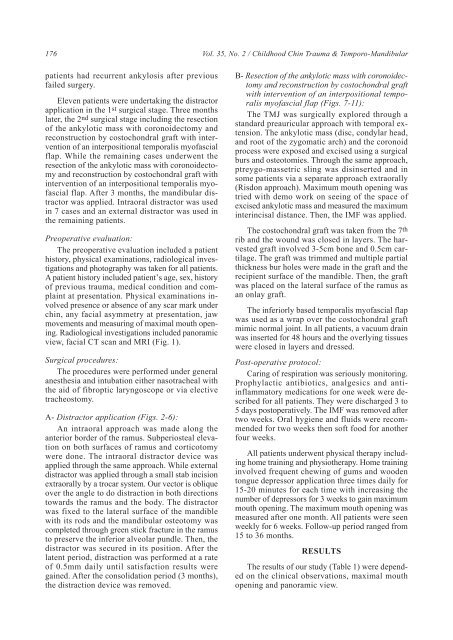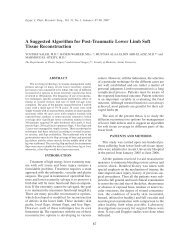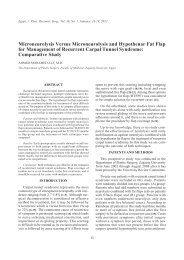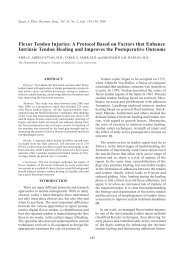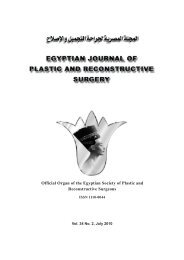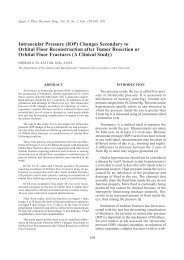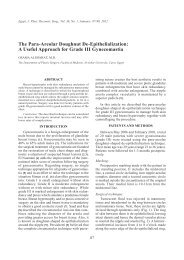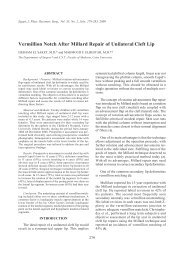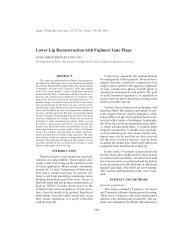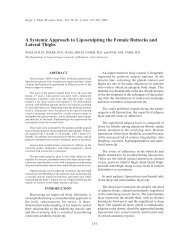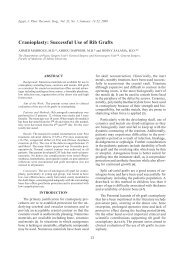Childhood Chin Trauma and Temporo-Mandibular Joint ... - ESPRS
Childhood Chin Trauma and Temporo-Mandibular Joint ... - ESPRS
Childhood Chin Trauma and Temporo-Mandibular Joint ... - ESPRS
You also want an ePaper? Increase the reach of your titles
YUMPU automatically turns print PDFs into web optimized ePapers that Google loves.
176 Vol. 35, No. 2 / <strong>Childhood</strong> <strong>Chin</strong> <strong>Trauma</strong> & <strong>Temporo</strong>-M<strong>and</strong>ibular<br />
patients had recurrent ankylosis after previous<br />
failed surgery.<br />
Eleven patients were undertaking the distractor<br />
application in the 1 st surgical stage. Three months<br />
later, the 2 nd surgical stage including the resection<br />
of the ankylotic mass with coronoidectomy <strong>and</strong><br />
reconstruction by costochondral graft with intervention<br />
of an interpositional temporalis myofascial<br />
flap. While the remaining cases underwent the<br />
resection of the ankylotic mass with coronoidectomy<br />
<strong>and</strong> reconstruction by costochondral graft with<br />
intervention of an interpositional temporalis myofascial<br />
flap. After 3 months, the m<strong>and</strong>ibular distractor<br />
was applied. Intraoral distractor was used<br />
in 7 cases <strong>and</strong> an external distractor was used in<br />
the remaining patients.<br />
Preoperative evaluation:<br />
The preoperative evaluation included a patient<br />
history, physical examinations, radiological investigations<br />
<strong>and</strong> photography was taken for all patients.<br />
A patient history included patient’s age, sex, history<br />
of previous trauma, medical condition <strong>and</strong> complaint<br />
at presentation. Physical examinations involved<br />
presence or absence of any scar mark under<br />
chin, any facial asymmetry at presentation, jaw<br />
movements <strong>and</strong> measuring of maximal mouth opening.<br />
Radiological investigations included panoramic<br />
view, facial CT scan <strong>and</strong> MRI (Fig. 1).<br />
Surgical procedures:<br />
The procedures were performed under general<br />
anesthesia <strong>and</strong> intubation either nasotracheal with<br />
the aid of fibroptic laryngoscope or via elective<br />
tracheostomy.<br />
A- Distractor application (Figs. 2-6):<br />
An intraoral approach was made along the<br />
anterior border of the ramus. Subperiosteal elevation<br />
on both surfaces of ramus <strong>and</strong> corticotomy<br />
were done. The intraoral distractor device was<br />
applied through the same approach. While external<br />
distractor was applied through a small stab incision<br />
extraorally by a trocar system. Our vector is oblique<br />
over the angle to do distraction in both directions<br />
towards the ramus <strong>and</strong> the body. The distractor<br />
was fixed to the lateral surface of the m<strong>and</strong>ible<br />
with its rods <strong>and</strong> the m<strong>and</strong>ibular osteotomy was<br />
completed through green stick fracture in the ramus<br />
to preserve the inferior alveolar pundle. Then, the<br />
distractor was secured in its position. After the<br />
latent period, distraction was performed at a rate<br />
of 0.5mm daily until satisfaction results were<br />
gained. After the consolidation period (3 months),<br />
the distraction device was removed.<br />
B- Resection of the ankylotic mass with coronoidectomy<br />
<strong>and</strong> reconstruction by costochondral graft<br />
with intervention of an interpositional temporalis<br />
myofascial flap (Figs. 7-11):<br />
The TMJ was surgically explored through a<br />
st<strong>and</strong>ard preauricular approach with temporal extension.<br />
The ankylotic mass (disc, condylar head,<br />
<strong>and</strong> root of the zygomatic arch) <strong>and</strong> the coronoid<br />
process were exposed <strong>and</strong> excised using a surgical<br />
burs <strong>and</strong> osteotomies. Through the same approach,<br />
ptreygo-massetric sling was disinserted <strong>and</strong> in<br />
some patients via a separate approach extraorally<br />
(Risdon approach). Maximum mouth opening was<br />
tried with demo work on seeing of the space of<br />
excised ankylotic mass <strong>and</strong> measured the maximum<br />
interincisal distance. Then, the IMF was applied.<br />
The costochondral graft was taken from the 7 th<br />
rib <strong>and</strong> the wound was closed in layers. The harvested<br />
graft involved 3-5cm bone <strong>and</strong> 0.5cm cartilage.<br />
The graft was trimmed <strong>and</strong> multiple partial<br />
thickness bur holes were made in the graft <strong>and</strong> the<br />
recipient surface of the m<strong>and</strong>ible. Then, the graft<br />
was placed on the lateral surface of the ramus as<br />
an onlay graft.<br />
The inferiorly based temporalis myofascial flap<br />
was used as a wrap over the costochondral graft<br />
mimic normal joint. In all patients, a vacuum drain<br />
was inserted for 48 hours <strong>and</strong> the overlying tissues<br />
were closed in layers <strong>and</strong> dressed.<br />
Post-operative protocol:<br />
Caring of respiration was seriously monitoring.<br />
Prophylactic antibiotics, analgesics <strong>and</strong> antiinflammatory<br />
medications for one week were described<br />
for all patients. They were discharged 3 to<br />
5 days postoperatively. The IMF was removed after<br />
two weeks. Oral hygiene <strong>and</strong> fluids were recommended<br />
for two weeks then soft food for another<br />
four weeks.<br />
All patients underwent physical therapy including<br />
home training <strong>and</strong> physiotherapy. Home training<br />
involved frequent chewing of gums <strong>and</strong> wooden<br />
tongue depressor application three times daily for<br />
15-20 minutes for each time with increasing the<br />
number of depressors for 3 weeks to gain maximum<br />
mouth opening. The maximum mouth opening was<br />
measured after one month. All patients were seen<br />
weekly for 6 weeks. Follow-up period ranged from<br />
15 to 36 months.<br />
RESULTS<br />
The results of our study (Table 1) were depended<br />
on the clinical observations, maximal mouth<br />
opening <strong>and</strong> panoramic view.


